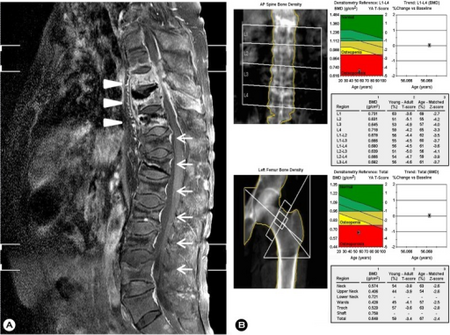Steroid-induced osteoporosis
| Steroid-induced osteoporosis | |
|---|---|
| Other names: SIOP | |
 | |
| a) MRI of spine - spondylitis of T8, 9, 10 and subligamentous abscesses arrow b) Low bone mineral density at lumbar spine/femur | |
| Medication | prednisone |
Steroid-induced osteoporosis is osteoporosis arising from the use of glucocorticoids (a class of steroid hormones) analogous to Cushing's syndrome but involving mainly the axial skeleton. The synthetic glucocorticoid prescription drug prednisone is a main candidate after prolonged intake. Bisphosphonates are beneficial in reducing the risk of vertebral fractures.[1] Some professional guidelines recommend prophylactic calcium and vitamin D supplementation in patients who take the equivalent of more than 30 mg hydrocortisone (7.5 mg of prednisolone), especially when this is in excess of three months.[2][3][4] The use of thiazide diuretics, and gonadal hormone replacement has also been recommended, with the use of calcitonin, bisphosphonates, sodium fluoride or anabolic steroids also suggested in refractory cases.[5] Alternate day use may not prevent this complication.[6]
It is also known as glucocorticoid-induced osteoporosis.[7]
Risk factors
The following increases the risk factor of this type of osteoporosis:[8]
- Eating disorder anorexia nervosa
- Cigarette smoking
- Alcohol abuse
- Low calcium
- Sedentary lifestyle
Mechanism
Mechanisms of SIOP include:[9]
- Direct inhibition of osteoblast function
- Direct enhancement of bone resorption
- Inhibition of gastrointestinal calcium absorption
- Increased urine calcium loss
- Inhibition of sex steroids
The combination of these changes leads to drug-induced nutrient depletion Archived 2021-03-05 at the Wayback Machine. Prednisone moderately depletes Archived 2021-11-06 at the Wayback Machine calcium,[10] vitamin D,[11] chromium[12] and magnesium. This explains why the professional guidelines recommend calcium and vitamin D supplementation.[13]
Diagnosis
The diagnosis of osteoporosis can be made using conventional radiography and by measuring the bone mineral density (BMD). The most popular method of measuring BMD is Dual-energy X-ray absorptiometry.
In addition to the detection of abnormal BMD, the diagnosis of osteoporosis requires investigations into potentially modifiable underlying causes; this may be done with blood tests. Depending on the likelihood of an underlying problem, investigations for cancer with metastasis to the bone, multiple myeloma, Cushing's disease and other above-mentioned causes may be performed.
Prevention
Among the preventive measures an individual can take to curtail this type of osteoporosis are:[8]
- Physically active
- Quit smoking
- Decrease your risk of falling
References
- ↑ Allen CS, Yeung JH, Vandermeer B, Homik J (October 2016). "Bisphosphonates for steroid-induced osteoporosis". The Cochrane Database of Systematic Reviews. 10: CD001347. doi:10.1002/14651858.CD001347.pub2. PMC 6461188. PMID 27706804.
- ↑ Bone and Tooth Society of Great Britain, National Osteoporosis Society, Royal College of Physicians (2003). Glucocorticoid-induced Osteoporosis (PDF). London, UK: Royal College of Physicians of London. ISBN 978-1-86016-173-5. Archived (PDF) from the original on 2009-03-18. Retrieved 2021-09-03.
{{cite book}}: CS1 maint: multiple names: authors list (link) - ↑ Homik J, Suarez-Almazor ME, Shea B, Cranney A, Wells G, Tugwell P (2000). "Calcium and vitamin D for corticosteroid-induced osteoporosis". The Cochrane Database of Systematic Reviews (2): CD000952. doi:10.1002/14651858.CD000952. PMC 7046131. PMID 10796394.
- ↑ Buckley, Lenore; Guyatt, Gordon; Fink, Howard A.; Cannon, Michael; Grossman, Jennifer; Hansen, Karen E.; Humphrey, Mary Beth; Lane, Nancy E.; Magrey, Marina; Miller, Marc; Morrison, Lake (August 2017). "2017 American College of Rheumatology Guideline for the Prevention and Treatment of Glucocorticoid-Induced Osteoporosis". Arthritis Care & Research. 69 (8): 1095–1110. doi:10.1002/acr.23279. ISSN 2151-4658. PMID 28585410. Archived from the original on 2021-05-23. Retrieved 2021-09-03.
- ↑ Lukert BP, Raisz LG (March 1990). "Glucocorticoid-induced osteoporosis: pathogenesis and management". Annals of Internal Medicine. 112 (5): 352–64. doi:10.7326/0003-4819-112-5-352. PMID 2407167.
- ↑ Gourlay M, Franceschini N, Sheyn Y (February 2007). "Prevention and treatment strategies for glucocorticoid-induced osteoporotic fractures". Clinical Rheumatology. 26 (2): 144–53. doi:10.1007/s10067-006-0315-1. PMID 16670825. S2CID 26017061.
- ↑ Buckley, Lenore; Guyatt, Gordon; Fink, Howard A.; Cannon, Michael; Grossman, Jennifer; Hansen, Karen E.; Humphrey, Mary Beth; Lane, Nancy E.; Magrey, Marina; Miller, Marc; Morrison, Lake (August 2017). "2017 American College of Rheumatology Guideline for the Prevention and Treatment of Glucocorticoid-Induced Osteoporosis". Arthritis Care & Research. 69 (8): 1095–1110. doi:10.1002/acr.23279. ISSN 2151-4658. PMID 28585410. Archived from the original on 2021-05-23. Retrieved 2021-09-03.
- ↑ 8.0 8.1 "Glucocorticoid-induced Osteoperosis". www.rheumatology.org. American College of Rheumatology. Archived from the original on 28 July 2021. Retrieved 9 November 2021.
- ↑ Steroid-induced osteoporosis Archived 2009-02-25 at the Wayback Machine By Susan Ott, MD. Updated January 28, 2009. Retrieved on 26 March 2009
- ↑ "Office of Dietary Supplements - Calcium". ods.od.nih.gov. Archived from the original on 2020-07-21. Retrieved 2020-07-24.
- ↑ "Office of Dietary Supplements - Vitamin D". ods.od.nih.gov. Archived from the original on 2020-07-23. Retrieved 2020-07-24.
- ↑ "Office of Dietary Supplements - Dietary Supplement Fact Sheet: Chromium". ods.od.nih.gov. Archived from the original on 2021-10-06. Retrieved 2020-07-24.
- ↑ Buckley, Lenore; Guyatt, Gordon; Fink, Howard A.; Cannon, Michael; Grossman, Jennifer; Hansen, Karen E.; Humphrey, Mary Beth; Lane, Nancy E.; Magrey, Marina; Miller, Marc; Morrison, Lake (August 2017). "2017 American College of Rheumatology Guideline for the Prevention and Treatment of Glucocorticoid-Induced Osteoporosis". Arthritis Care & Research. 69 (8): 1095–1110. doi:10.1002/acr.23279. ISSN 2151-4658. PMID 28585410. Archived from the original on 2021-05-23. Retrieved 2021-09-03.